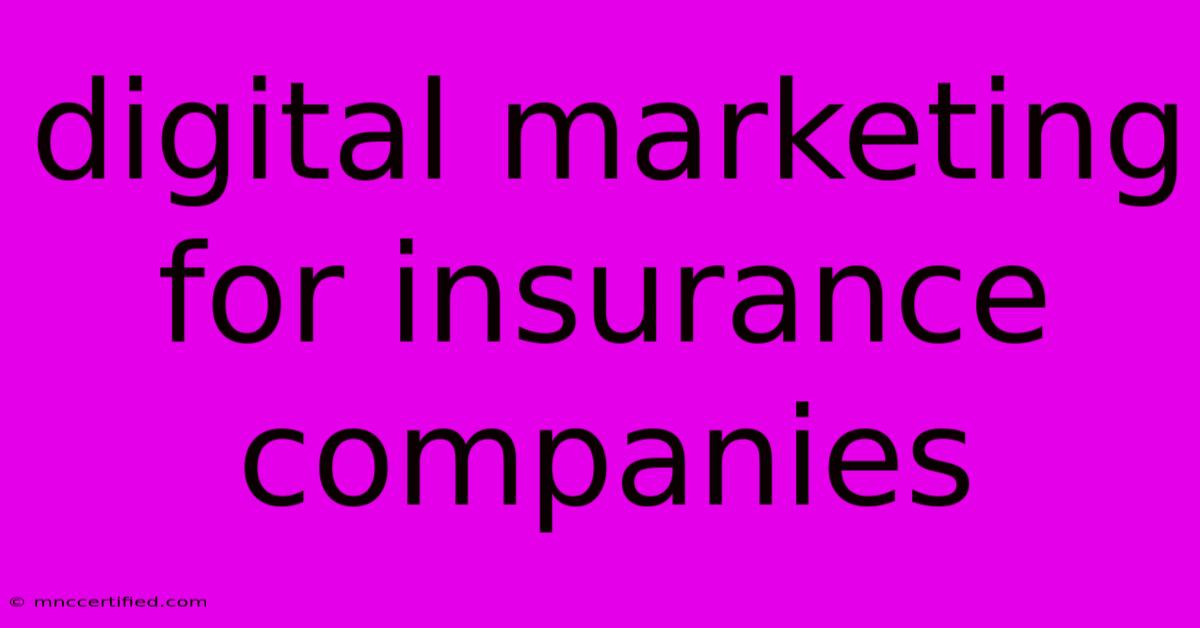Digital Marketing For Insurance Companies

Table of Contents
Digital Marketing for Insurance Companies: A Comprehensive Guide to Growth
The insurance industry is undergoing a digital transformation. Gone are the days of relying solely on traditional marketing methods. Today, insurance companies need to embrace digital strategies to connect with modern consumers, increase brand awareness, and drive sales. This comprehensive guide explores the key aspects of digital marketing for insurance companies, equipping you with the knowledge and tools to thrive in the competitive landscape.
Understanding Your Target Audience
Before diving into specific strategies, it's crucial to understand your target audience. Different demographics have unique needs and preferences, so tailoring your approach is essential. Consider factors such as:
- Age: Millennials and Gen Z are digitally savvy and prefer online interactions.
- Lifestyle: Active individuals might prioritize health insurance, while families with young children focus on life and disability coverage.
- Financial Situation: Budget-conscious consumers may search for affordable options, while high-net-worth individuals require tailored solutions.
Essential Digital Marketing Strategies for Insurance Companies
1. Website Optimization:
- Mobile-Friendly Design: A responsive website that adapts seamlessly to different devices is crucial. Users should have a smooth experience regardless of whether they browse on a desktop, tablet, or smartphone.
- Clear and Concise Content: Explain complex insurance terms in simple language. Include FAQ sections, testimonials, and case studies to build trust and credibility.
- Search Engine Optimization (SEO): Optimize your website for relevant keywords to rank higher in search engine results pages (SERPs).
- Call to Action (CTA): Guide visitors towards desired actions, such as obtaining a quote, requesting a consultation, or downloading a brochure.
2. Content Marketing:
- Blog Posts: Share insightful articles on insurance topics, provide tips on managing risk, and offer valuable advice to your target audience.
- Infographics: Visual representations of data and information can be easily shared on social media and attract attention.
- Videos: Create educational videos explaining insurance concepts, product demos, or customer testimonials.
- Email Marketing: Segment your audience and send targeted emails with relevant information, promotions, and updates.
3. Social Media Marketing:
- Active Engagement: Build a strong online community by engaging with followers, responding to comments, and participating in relevant discussions.
- Targeted Advertising: Utilize social media platforms like Facebook, Instagram, and LinkedIn to reach specific demographics and interests.
- Contests and Giveaways: Run engaging campaigns to increase brand awareness, generate leads, and build excitement.
4. Paid Advertising:
- Search Engine Marketing (SEM): Run targeted advertising campaigns on Google Ads to reach users searching for specific insurance products or services.
- Social Media Advertising: Utilize platforms like Facebook and Instagram to promote your services and reach a wider audience.
- Retargeting: Re-engage website visitors who showed interest but didn't convert by displaying targeted ads across various platforms.
5. Data Analytics:
- Tracking and Measurement: Monitor key metrics such as website traffic, lead generation, conversion rates, and customer engagement.
- Data-Driven Decisions: Use insights from data analytics to refine your strategies, optimize your campaigns, and identify areas for improvement.
Leveraging Digital Technology for Success
- Artificial Intelligence (AI): AI-powered chatbots can provide instant customer support, answer frequently asked questions, and streamline the insurance process.
- Internet of Things (IoT): Integrate connected devices like smart home sensors and wearable fitness trackers to offer personalized insurance solutions and risk management strategies.
- Big Data: Analyze large datasets to understand customer needs, identify trends, and develop innovative insurance products.
Key Considerations for Digital Marketing Success
- Budget: Allocate your resources wisely and prioritize strategies that align with your overall marketing goals.
- Time Commitment: Digital marketing requires consistent effort and ongoing optimization to achieve desired results.
- Adaptability: Stay up-to-date with the latest trends and technologies in the ever-evolving digital landscape.
Conclusion
Digital marketing is no longer optional for insurance companies. By embracing these strategies, you can reach new customers, build brand loyalty, and achieve sustainable growth in the competitive insurance industry.
Remember, the key is to understand your target audience, choose the right tools and platforms, and continuously adapt your approach to stay ahead of the curve. By combining innovative technology with effective marketing strategies, insurance companies can thrive in the digital age.

Thank you for visiting our website wich cover about Digital Marketing For Insurance Companies. We hope the information provided has been useful to you. Feel free to contact us if you have any questions or need further assistance. See you next time and dont miss to bookmark.
Featured Posts
-
How To Get Iv Fluids Covered By Insurance
Nov 07, 2024
-
San Francisco Mayoral Election Lurie Leads
Nov 07, 2024
-
Alfa Vienna Insurance Group Biztosito Zrt
Nov 07, 2024
-
Are Garage Doors Covered By Home Insurance
Nov 07, 2024
-
Luton Town Vs Cardiff City Team News
Nov 07, 2024